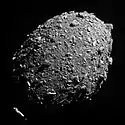Emirates Lunar Mission
The Emirates Lunar Mission (Arabic: مشروع الإمارات لاستكشاف القمر) was the first mission to the Moon from the United Arab Emirates.[2]
 | |
| Mission type | Lunar rover |
|---|---|
| Mission duration | Achieved: 134 days |
| Spacecraft properties | |
| Spacecraft | Rashid |
| Dry mass | 10 kg (22 lb) |
| Dimensions | 53.5 cm (21.1 in) × 53.85 cm (21.20 in) |
| Start of mission | |
| Launch date | 11 December 2022, 07:38:13 UTC[1] |
| Rocket | Falcon 9 Block 5 |
| Launch site | Cape Canaveral SLC-40 |
| Contractor | SpaceX |
| End of mission | |
| Last contact | 20 April 2023 |
| Lunar rover | |
| Landing date | April 25, 2023 |
| Landing site | Atlas Crater (planned) |
Emirates Planetary Programme | |
The mission by Mohammed bin Rashid Space Centre (MBRSC) sent a lunar rover named Rashid to the Moon aboard ispace's Hakuto-R Mission 1 lander.[1][3] It was launched on 11 December 2022 on a Falcon 9 Block 5 rocket,[4] and the rover attempted to land in Atlas crater.[5][6] On 25 April 2023, seconds before an attempted landing, communication with the Hakuto-R lander was lost.[6] The ispace team confirmed that the spacecraft had crashed into the Moon and was thus destroyed.[7][8]
Rover specifications
Rashid was equipped with two high-resolution cameras, a microscopic camera to capture small details, and a thermal imaging camera. The rover also carried a Langmuir probe, designed to study the Moon's plasma and attempt to explain why Moon dust is so sticky.[9] The rover was designed to study the lunar surface, mobility on the Moon’s surface and how different surfaces interact with lunar particles.[10][11]
Overview
The mission's initial timeline was to send the rover by 2024. On 14 April 2021, MBRSC announced that the schedule had been moved up to send the rover to the Moon by 2022, rather than 2024.[10] The rover is named Rashid in honor of Dubai's late ruler Sheikh Rashid bin Saeed Al Maktoum, who was responsible for the transformation of Dubai from a small cluster of settlements near the Dubai Creek to a modern port city and commercial hub. The rover was built in MBRSC in Dubai by Emiratis, making it the first Arab country to send a mission to the Moon.[11]
HAKUTO-R lander
As the United Arab Emirates did not plan to build its own lander, it contracted with the Japanese company ispace for a lunar landing. The Emirates Lunar Mission was the first Moon trip for Hakuto-R, which ispace was developing for more than a decade. The company, which was established in 2010, managed Team Hakuto, one of the five finalists in the Google Lunar X Prize. The private race to the Moon ended in 2018 without a winner.[12]
References
- Rosenstein, Sawyer (11 December 2022). "SpaceX launches Falcon 9 carrying private Japanese moon lander". NASASpaceFlight. Retrieved 11 December 2022.
- Abueish, Tamara (29 September 2020). "UAE to launch new Emirati space mission to explore moon: Dubai ruler". Al Arabiya English. Retrieved 6 October 2020.
- "MBRSC Teams Up with Japan's ispace on Emirates Lunar Mission". ispace. 14 April 2021. Retrieved 14 April 2021.
- Rosenstein, Sawyer (11 December 2022). "SpaceX launches Falcon 9 carrying private Japanese moon lander". NASASpaceFlight. Retrieved 11 December 2022.
- "ispace Announces Mission 1 Launch Date". ispace. 17 Nov 2022. Retrieved 17 Nov 2022.
- Chang, Kenneth (2023-04-25). "Live Updates: A Japanese Company Attempts the 1st Private Moon Landing". The New York Times. ISSN 0362-4331. Retrieved 2023-04-25.
- "Status Update on ispace Hakuto-R Mission 1 Lunar Lander". ispace. Retrieved 2023-04-26.
- "Japan Spacecraft Believed to Have Crashed on Moon During Landing". Bloomberg.com. 2023-04-25. Retrieved 2023-04-27.
- "UAE hopes this tiny lunar rover will discover unexplored parts of the moon". CNN. 24 November 2020.
- "UAE sets new ambitious timeline for launch of moon rover". ABC News. 14 April 2021.
- "UAE to send Emirati-made lunar rover 'Rashid' to the moon next year". Gulf News. 14 April 2021.
- "Japanese ispace lander to carry UAE moon rover to lunar surface in 2022". Space.com. 14 April 2021.

